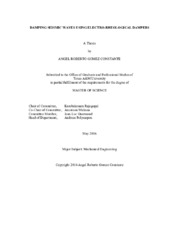| dc.description.abstract | The recent seismic scale that the world has been experiencing, with earthquakes of uncommon intensity has triggered the alarms of the world scientific community due to the devastating aftermaths in terms of infrastructure damage and destruction as well as loss of human lives. It is necessary to develop special mechanical systems that can attenuate such catastrophic effects. One relatively new method for vibration control is the utilization of dampers that use a so called electro-rheological viscous fluid which can experience a substantial change in its viscosity as a controlled electric field runs through it. This methodology is known as a semi-active control system, which, instead of introducing active control forces or passive vibration absorbers, uses a variable rate of damping or stiffness.
The main objective of this work is to analyze this non-linear system response using numerical approximations, in which the damping force depends on the electric field, which at the same time, could depend on the relative velocity of the system. As a first task, the damping force is defined for this semi-active vibration control system. The electric field stands out as the damping modifier, therefore, it is the main input variable of the analysis. Later, a group of cases of study are defined in order to analyze the effect of the variation of the electric field on the damping force and system response. The cases of study where the damping force is analyzed are 1) electric field is zero, 2) electric field is constant and equal to the maximum, and, 3) electric field is a function of the relative velocity of the system (E = E(v)). For these cases of study, the reduce of system response amplitude is significant, which proves the benefits of the method. | en |


